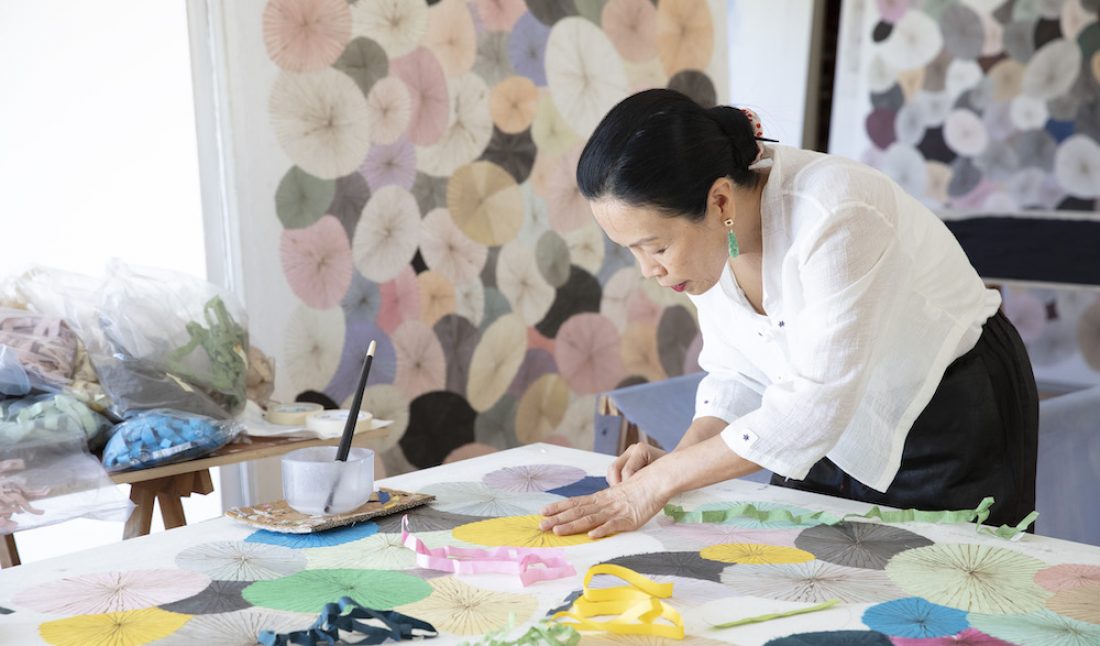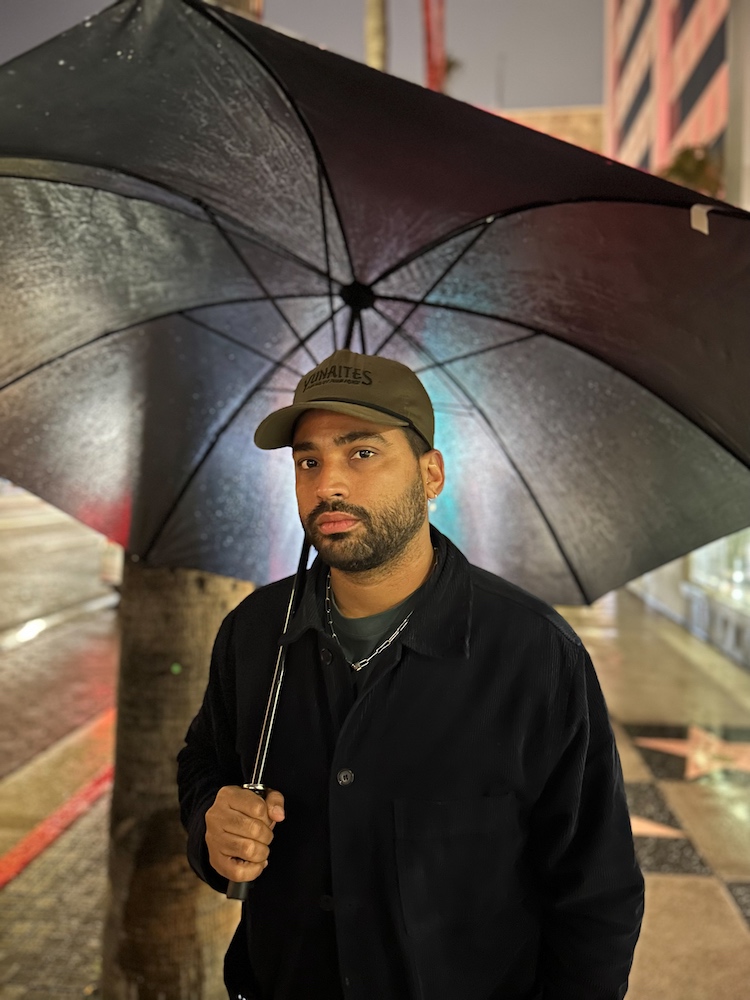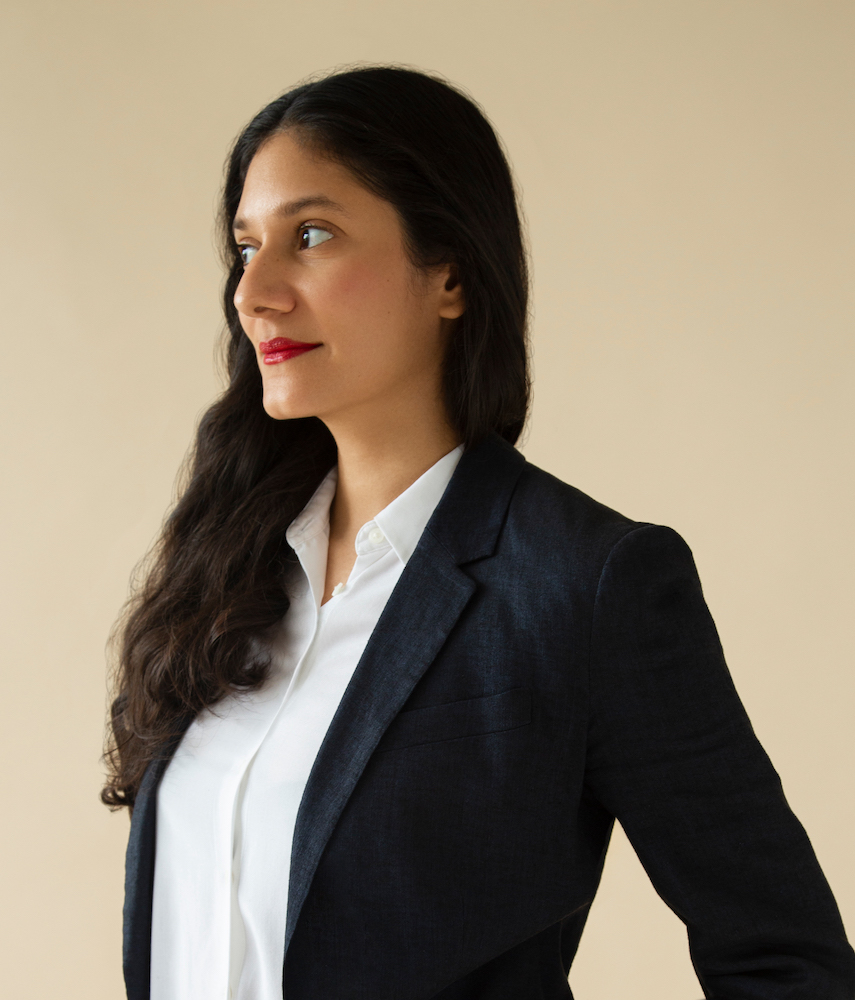When Minjung Kim talks about her work, she describes her materials as her collaborators. For decades, Kim has worked with hanji, a Korean paper made from mulberry trees, and ink made from the trees’ smoke, meaning that she understands its intricacies and behaviors better than most people know themselves. She can anticipate how the ink will pool or dissolve, what it will look and feel like to intervene on the paper’s surface or burn its edges. Kim considers the paper an extension of her own skin; they are a continuous loop, just as the paper and ink represent the complete life cycle of a mulberry tree.
Now in her sixties, Kim discusses her practice, life, and career with the frankness that comes with mastery. She has spent almost her entire life being told or knowing that she would become an artist, but to pursue her work has required an intense internal strength. When she moved from Korea to Italy in 1991, for example, her techniques were off-trend, out of step with the turn toward photography and film. Despite external pressures and a difficult life, Kim has only pursued her own inclinations, rather than falling prey to these vicissitudes.
Whitewall caught up with Kim before her upcoming solo show at Almine Rech (opening April 26, 2024). As we spoke, she shared more about her initial interests in artmaking, finding success later in life, and where her strength comes from.
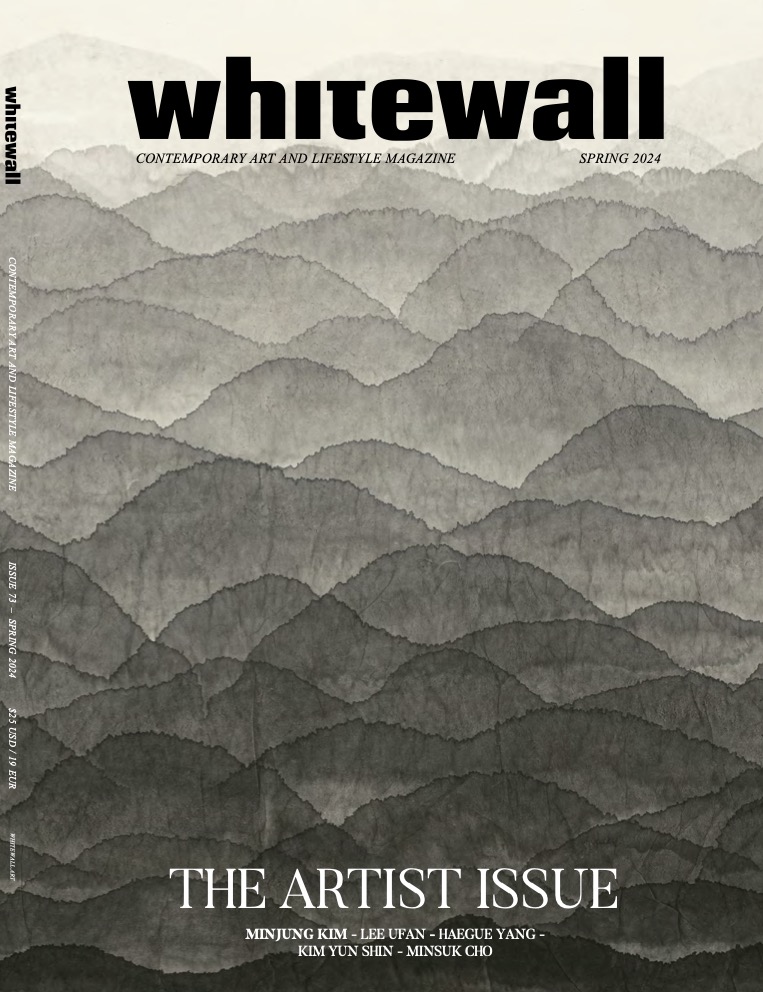 Minjung Kim, “Mountain,” 2021, ink on mulberry Hanji paper, 136 x 173.5 cm, Gallery HYUNDAI, courtesy of the artist, © Minjung Kim.
Minjung Kim, “Mountain,” 2021, ink on mulberry Hanji paper, 136 x 173.5 cm, Gallery HYUNDAI, courtesy of the artist, © Minjung Kim.
WHITEWALL: My first question goes all the way back to the beginning. I know you’ve spoken in other interviews about how your mother knew that you had a talent for art. I wondered what it felt like for you making art at such an early age, and if you also recognized that you were talented?
MINJUNG KIM: You know, when we are young, your whole world is your family or your parents. How could I know I was good? Whenever there was an art competition, I always received the first prize, so my mom would say, “You are very talented.” And when I received such prizes, I felt like maybe I was indeed talented. My mom was very intellectually left-wing. After the war in Korea, there was a time when the children of left-wing individuals couldn’t pursue certain professions. They were awfully oppressed by the dictator.
Looking back now, I understand why they would say, “You are talented.” We were not allowed to become teachers or judges. I had aspirations to become a judge; I always talked about wanting to punish bad people. However, they would say, “You’re so talented, you should pursue art.” Our parents pushed me in that direction, and I didn’t question it. However, they never imposed their left-wing views on me. Then, I had private art teachers, private calligraphy tutors, who would say, “You are talented.” So I truly believed it. When you’re young, you’re often too inexperienced to decide what you want to do. We were Korean kids, very respectful toward our parents. So, when our parents decided that we were going to pursue a certain path, we believed it too. Now, at 60 years old, I realize that I was born to be an artist.
“Now, at 60 years old, I realize that I was born to be an artist,” —Minjung Kim
WW: And you never stopped practicing.
MK: I have never stopped doing artwork. Your personal life can be very challenging, and mine was no exception. It was not an easy life. However, throughout my life, I prioritized and accommodated being an artist and never ceased working.
As you may have read in my biography, I came to Italy. I have a deep love for the Renaissance, which is why I chose to settle here. However, my chosen medium of paper was not well received in the art world during the nineties, a time when photography and video were in vogue. When I presented my artworks to galleries, they often dismissed it, saying, “You don’t work with oil paint.” At that time, I just kept on going. I persevered. Success comes so late, so I couldn’t stop working.
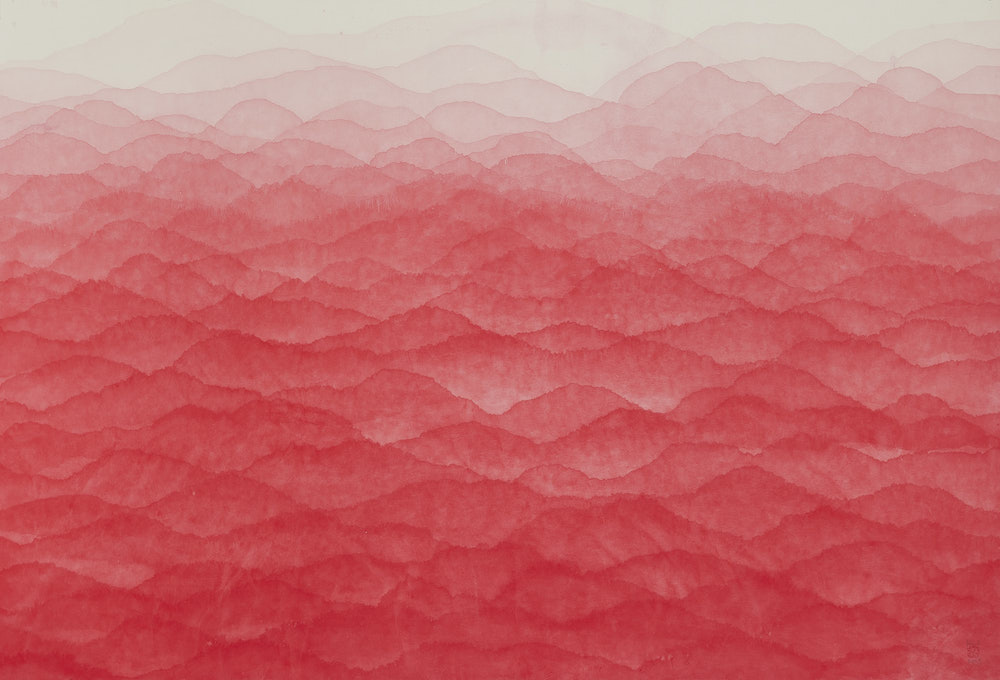 Minjung Kim, “Red Mountain,” 2021, 139 x 205 cm, ink and watercolor on mulberry Hanji paper, Saint Paul de Vence, courtesy of the artist, © Minjung Kim.
Minjung Kim, “Red Mountain,” 2021, 139 x 205 cm, ink and watercolor on mulberry Hanji paper, Saint Paul de Vence, courtesy of the artist, © Minjung Kim.
WW: Did you feel like the resistance to your work was the same in Italy as it was in Korea, or did it have a kind of different quality to it?
MK: Well, upon my arrival, my professor said, “Since you’re in Italy, why not embrace something new? That means you should change your medium.” I had been working all my life, till 28, 29, with paper. It’s like completely changing your color if you abandon it. Like after exclusively eating rice for years and suddenly switching to only meat.
I thought that being in this country meant I had to change my skin. But I didn’t change it; I stuck to what I knew best and could do well. I’m very stubborn. I said thank you, but no. And of course, nobody paid much attention to me at the time. I aimed for success at the age of 60. I observed what people typically consider a successful artist, and I realized they often can’t carry on for too long. With success comes a lack of freedom to drastically change your work. So I planned it. I said, “Nobody look at me.”
Then, life progresses; you get married, you have children. Your career isn’t the main focus anymore. True success isn’t about external achievements. A successful life is when you’re happy, and when you have your own identity. You keep on growing your strengths. This, to me, is a successful life. And whatever you pursue, you’ll have the results of that fulfilling life.
WW: What you’re saying is so interesting, given the art market, where so many trends seem to crop up.
MK: When we decide to be artists, we understand what we are committing to. We are not seeking success or money. However, in the younger generation, artists immediately associate being an artist with financial gain or success. Furthermore, art schools often focus on teaching students how to exhibit their work rather than fostering personal growth and character development. Observing these young artists, they tend to discuss similar themes.
Typically, artists shouldn’t talk because we are dealing with something where there is no language. There is something beyond. Perhaps I cannot fully explain all that I do (also, the more you explain, the weaker your art becomes). I perceive art as a sacred relationship between God and humans. You are born to fulfill this role. That’s what I feel.
WW: You’re saying that art is a kind of divine inspiration, and I’m wondering if that is part of the reason why you connect so much with the Italian Renaissance?
MK: I am drawn to the Italian Renaissance because of my appreciation for skills. The Renaissance era was renowned for its mastery of skills. Despite limitations imposed by religious constraints, artists of that time managed to express themselves in remarkable ways. Skill is essential because it empowers one to create even in the absence of words.
Immersing oneself in a chosen material is crucial. Personally, I worked with paper for 40 years, and despite feeling like I had explored every possibility, there was always something new to discover. Mastery deepens over time as one becomes intimately familiar with their chosen medium. For me, working with paper feels like an extension of my own skin. This deep connection allows for true freedom of expression with the material.
““When we decide to be artists, we understand what we are committing to. We are not seeking success or money,” —Minjung Kim
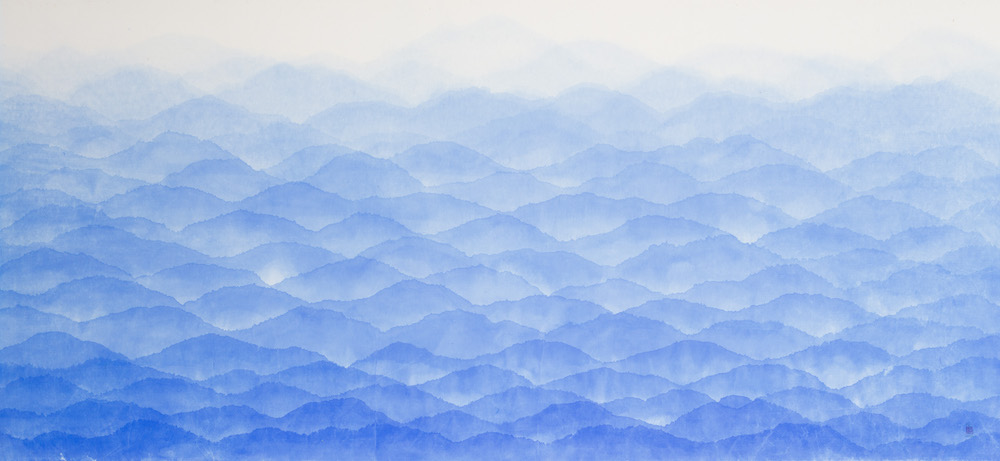 Minjung Kim, “Blue mountain,” 2022, watercolor on mulberry Hanji paper 95 x 205 cm, Saint Paul de Vence (location), courtesy of the artist, © Minjung Kim.
Minjung Kim, “Blue mountain,” 2022, watercolor on mulberry Hanji paper 95 x 205 cm, Saint Paul de Vence (location), courtesy of the artist, © Minjung Kim.
WW: What you’re describing requires intense personal strength to keep going and to keep to yourself. I see so much in your work that it has its own atmosphere. And I wonder if for you that atmosphere is a version of yourself?
MK: Yes, I believe so. I used to live in Milan, but I moved to the countryside because I didn’t want to see people. I adore people, but it’s poisoning; being constantly surrounded by them can be draining. I find solace in melancholic isolation. Throughout my life, I’ve strived to create situations that offer the best circumstances and conditions to create solitude and my art. So I think whenever I do something, maybe it comes out like you describe.
I had a miserable life. So, if I don’t burn this very simple paper, I could kill myself. It served as a form of discipline, to survive. But at the same time, I’ve always considered myself an artist who creates beauty. I never aimed to evoke feelings of anger or sorrow.
WW: I know mulberry paper is very chemically stable. I was thinking about that in relation to the kind of constancy and cyclicality of your work. Is the chemical stability of the paper something that you think about when you’re working?
MK: When I was young, my father practiced calligraphy and often used mulberry paper. So this paper was everywhere in the household during that time. It’s not that I consciously chose it because I knew about its consistent chemical pH, no; rather, I am grateful that I was exposed to such high-quality paper from a young age.
Some people ask me if I’ll make my own paper, and no, I never think of it. Master papermakers already produce fantastic paper. Why should I waste my time and take away their jobs? I typically purchase paper from Korea; I buy around 100 kilos of paper, and then send some to New York. I consume it all.
Paper is already a form of minimal art. When I see the paper, when I do any action involving it, I feel I’m violently interrupting its profound silence and peace. I really serve the paper, and it often tells me what I should do. I like this collaboration with the material. Even though it’s so thin and delicate, paper possesses a strong character, unique traits, their inherent acceptance. I have to learn about their character. With the paper I became humble. Working with this material makes me a better person.
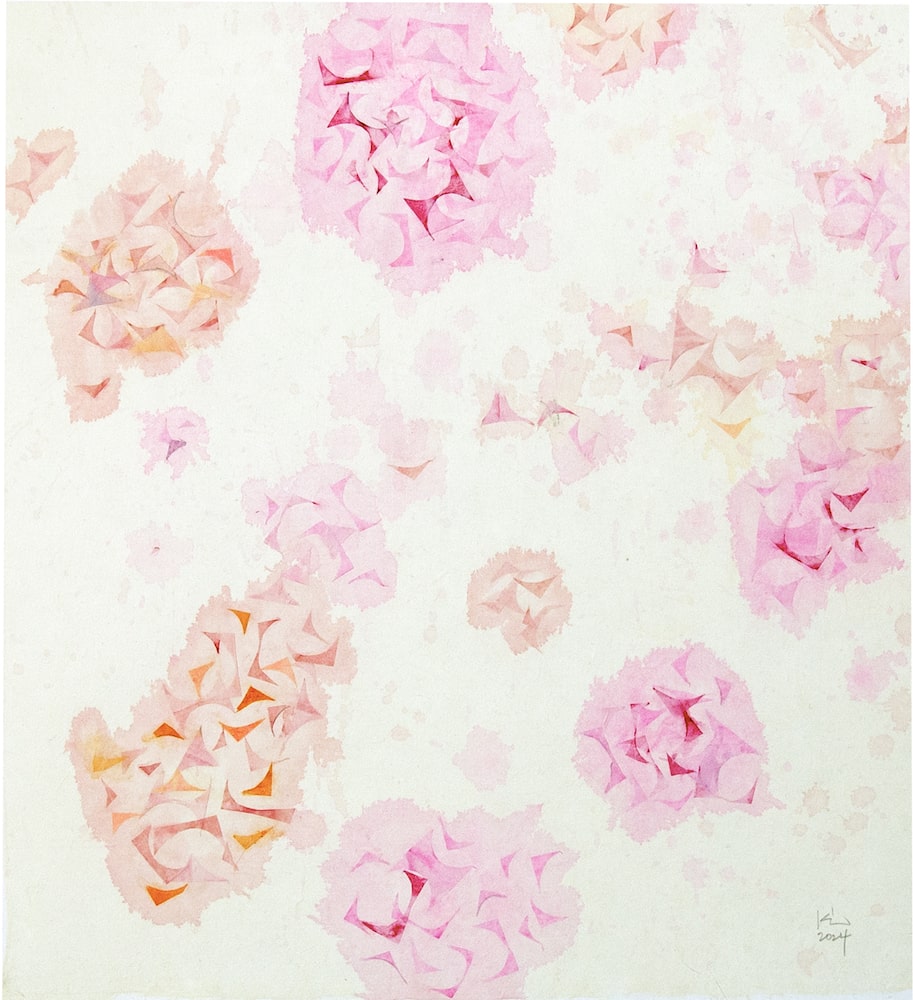 Minjung Kim, “Regeneration,” 2024, mixed media on mulberry Hanji paper 47 x 41,5 cm, courtesy of the artist, © Minjung Kim.
Minjung Kim, “Regeneration,” 2024, mixed media on mulberry Hanji paper 47 x 41,5 cm, courtesy of the artist, © Minjung Kim.
WW: It makes you listen and respect its agency. I’m interested in this and the isolation that you cultivate. Do you feel that you have to be in a certain state of mind to start working?
MK: When you attend a dinner party, you’re excited, so happy. You need time to calm down. I need a few days to settle down. I like being around people; I’m endlessly curious. However, at some point, I understood that life is too short, as we often say. I’ve come to understand that I was born to be an artist. Now, at 60 years old, I cannot afford to waste time. So many people say, when they see my work, I am almost like a monk, when they see my work. But no, in reality, I’m anything but serene. That’s precisely why I do what I do—it helps me find inner peace. If I were already as calm as a monk, I wouldn’t feel the need to pursue this profession.
““You are born to fulfill this role,” —Minjung Kim
WW: Is it almost like you’re emptying yourself when you’re working?
MK: It’s the only problem of the soul. All the emotional negativities make us sick physically and mentally. It’s all about your ego. Ego decides. Ego judges. The ego wants to be accepted. When it comes to artwork, focusing is essential. Repetition is meditative. Although I don’t like to use this word now, because everyone uses meditation, and I don’t know how much people really do. However, when I’m burning paper, that’s exactly how it feels. If you’re not fully focused, you burn your fingers. With repeated movements, it becomes automatic. You lose yourself, and transcend your own ego. And I believe this is truly beneficial for me.
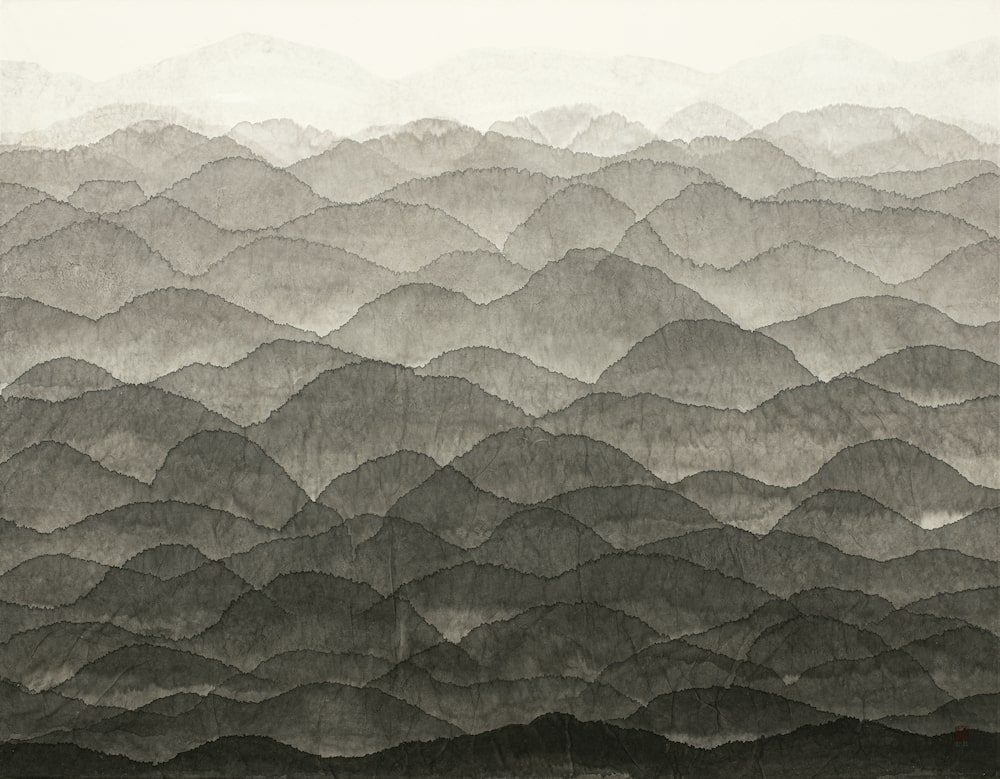 Minjung Kim, “Mountain,” 2021, ink on mulberry Hanji paper, 136 x 173.5 cm, Gallery HYUNDAI, courtesy of the artist, © Minjung Kim.
Minjung Kim, “Mountain,” 2021, ink on mulberry Hanji paper, 136 x 173.5 cm, Gallery HYUNDAI, courtesy of the artist, © Minjung Kim.
WW: I wanted to ask about your “Mountain” series. When I look at it, it feels like it is not a vertical depth, but a horizontal depth, sort of like an interior mountain. But given the title, I wondered if you felt it was more about landscape?
MK: You’re a sensible person. You understand. At that time, I was in Italy without any inspiration for new art. So I decided to venture to the seaside, thinking, “We’ll see what happens.” I ended up in the Positano area, where I rented a room, and this is what I painted.
This room overlooked the cliff by the sea [makes crashing sounds]. Then I was thinking, “Can I paint the sounds of the water and of the tide? How can I paint the sounds of the tide?” I never sketch my artwork. I started painting. I looked at it, and it seemed like a mountain. I liked the duality—it was my intention to paint water, and it transformed into earth.
WW: When I look at these pieces, it makes me pay attention more to my own breathing, the quietness of existence. I imagine the watercolor touching the paper. It creates a second set of music.
MK: You know, the ink I’m using is made by the smoke of the tree. They burn the trees, then the smoke goes up, they take it, and this becomes ink. So basically, you paint with smoke. If you think about it, the paper is made by the tree, and from the tree they make ink, and the ink you put there is a transformation of the same material, so they’re harmonious. The basic material itself, whatever you use, is ready-made art. So art is everywhere. And you don’t need that much intervention.
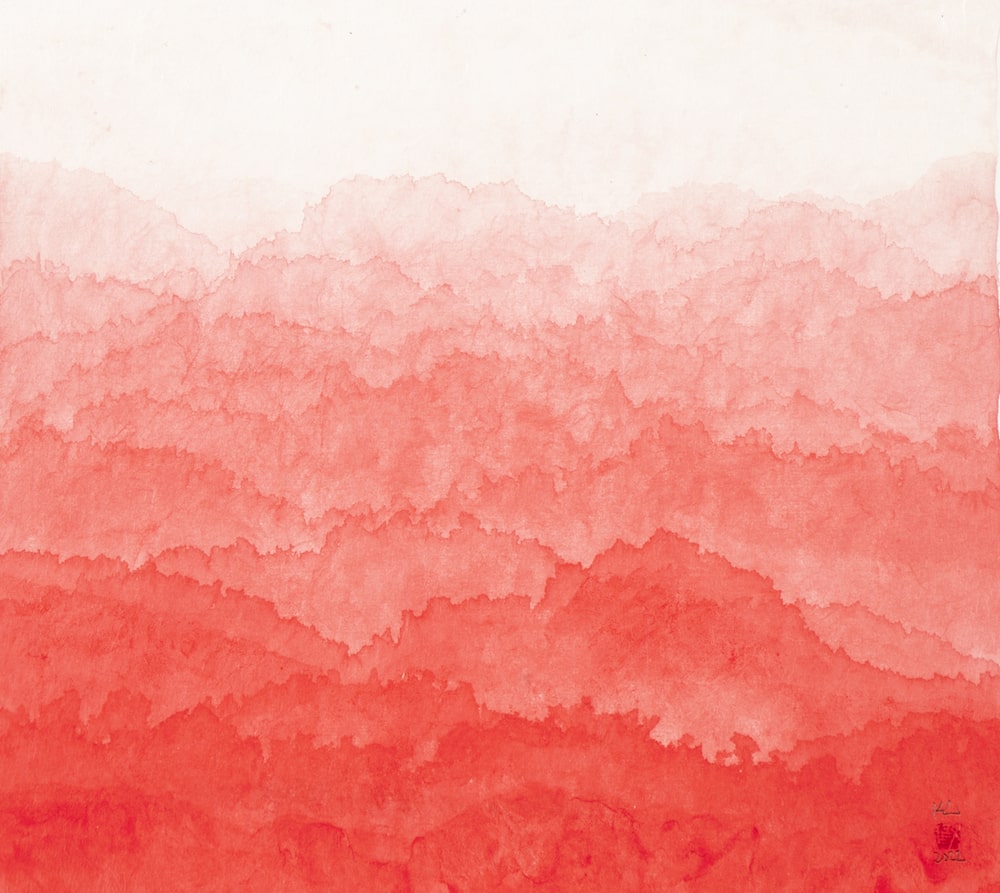 Minjung Kim, “Red Mountain,” 2022, watercolor on mulberry Hanji paper, 31 x 35.5 cm, Saint Paul de Vence, courtesy of the artist, © Minjung Kim.
Minjung Kim, “Red Mountain,” 2022, watercolor on mulberry Hanji paper, 31 x 35.5 cm, Saint Paul de Vence, courtesy of the artist, © Minjung Kim.
WW: What I like so much about all of this is the cyclical quality. The life cycle of the mulberry also seems to parallel your own interests. In the smoke, I see the sfumato or the chiaroscuro of Italian art. These components naturally gravitate toward each other.
MK: You talk very well. When you do interviews, you have to have the same spirit for it to be easy to discuss. You have what is in your mind, and it comes out of another’s mouth.
WW: I also wanted to ask, besides the materiality of your work, do you feel there is something innately Korean about what you do?
MK: I lived in the West for more than half of my life, but still I have strong Koreanity. But Koreanity is changing now. Young Korea is BTS! So I cannot say what is Korean now, but I am Korean of my time.
I was born in the sixties, and we have parents who were in the Korean War. We know poverty, how our parents sacrificed. Our parents’ generation worked hard. I’m very Korean-who-is-born-in-the-sixties. I still have the old, very traditional Korean mind. Somehow, we are a victim of our own time.
WW: And your parents lived under the Japanese occupation too?
MK: Yes, my parents, and they got independence. We had 36 years of Japanese colonization. Then Russia, America, Europe decide to divide the balance of power in our peninsula. All these things are our inheritance. Tragedy. We feel it. For thousands of years, we were continuously invaded by China, Japan, and Russia. And we had a lot to take as a small country. We are survivors. Koreans are very practical people.






